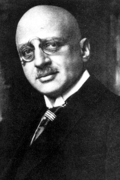Haber, Fritz (Agricultural & Resource Economics)

Haber, Fritz
| Topics: |
By 1905 Fritz Haber (1868–1934) had reached the objective long sought by chemists of fixing nitrogen from air. Using high pressure and a catalyst, he directly reacted nitrogen gas, which was generated by the Linde process, and hydrogen gas to create ammonia. The process was soon scaled up by BASF's great chemist and engineer Carl Bosch—hence the name "Haber-Bosch" process. The nitric acid produced from the ammonia was then used to manufacture agricultural fertilizers as well as explosives.
Haber was from a well-to-do German-Jewish family involved in various manufacturing enterprises. He studied at several German universities, earning a doctorate in organic chemistry in 1891. After a few years of moving from job to job, he settled into the Department of Chemical and Fuel Technology at the Polytechnic in Karlsruhe, Germany, where he mastered the new subject of physical chemistry. His research in physical chemistry eventually led to the Haber-Bosch process. In 1911 he was invited to become director of the Institute for Physical Chemistry and Electrochemistry at the new Kaiser Wilhelm Gesellschaft in Berlin, where academic scientists, government, and industry cooperated to promote original research.
The Haber-Bosch process is generally credited with keeping Germany supplied with fertilizers and munitions during World War I, after the British naval blockade cut off supplies of nitrates from Chile. During the war Haber threw his energies and those of his institute into further support for the German side. He developed a new weapon—poison gas, the first example of which was chlorine gas—and supervised its initial deployment on the Western Front at Ypres, Belgium, in 1915. His promotion of this frightening weapon precipitated the suicide of his wife, who was herself a chemist, and many others condemned him for his wartime role. There was great consternation when he was awarded the Nobel Prize in chemistry for 1918 for the synthesis of ammonia from its elements.
After World War I, Haber was remarkably successful in building up his institute, but in 1933 the anti-Jewish decrees of the Nazi regime made his position untenable. He retired a broken man, although at the time of his death he was on his way to investigate a possible senior research position at Rehovot in Palestine (now Israel).
Further Reading